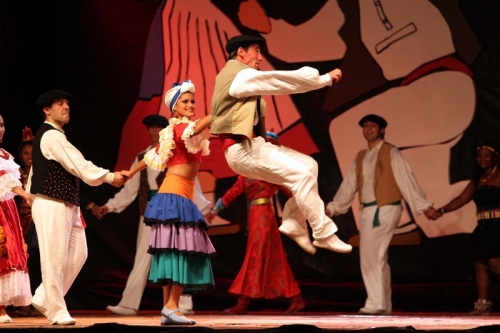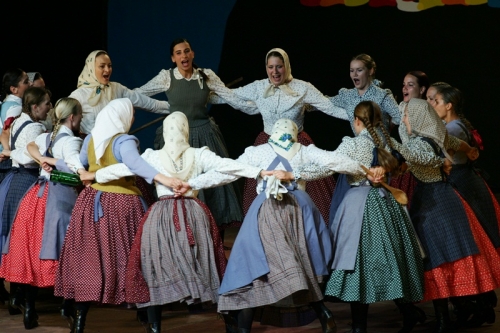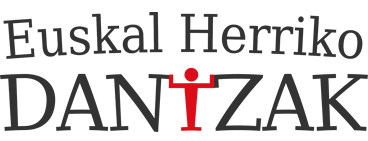The magic circle
- Pablo A. MARTÍN BOSCH, "Aritz".
- 15/ 10/ 2001
For a long time human beings, without going further back in evolution, have danced and they have not only done so individually, but also collectively. This has obliged them to adopt different figures within the representation. Perhaps one of the simplest of them among the group or social dances is the forming of circles. We see one, two, three and many more circle formations all over the world. On most occasions men occupy the centre and first women and then children extend outwards.
However, although a position closer to the centre indicates the status or position of a sex within the social structure going from higher to lower, we can draw other interesting conclusions for researchers of traditional dances.
Curt SACHS, in his Universal History of Dance (Ed. Centurión, 1944) bases his work on a fact that may seem irrelevant, but which gives us sufficiently clear ideas when interpreting the meaning of the circular or rope dances. In the book he states that when the Sun is in the Northern Hemisphere we always see it move from east to west going through the south, so if we observe its path it rises up on our left and later descends on our right. It follows what we would call a clockwise path; in fact, clocks with hands have copied this movement. Curt SACHS thus reaches the conclusion that the dances performed in clockwise direction must correspond to thinking or mythology which centres on the sun.
The moon, our "guide", generally follows the same day-time path. It rises in the east and goes down in the west after crossing through the southern zone. However, taking the same time of observation as a reference point, every day it is found a little further to the left than the day before. The path it follows is the same but as it goes a little more slowly, it seems to turn around and take a counter-clockwise direction.
Sun Dances and Moon Dances, dances dedicated to the day and night stars, dances of the hunter and agricultural dances contrast each other. It would be interesting to see how far this contrast reaches. However, our study covers Basque-speaking areas in the western Pyrenees and its foothills and Nafarroa, Zuberoa, Lapurdi, Araba, Gipuzkoa and Bizkaia. The fact is that in these areas we do not find dances performed in clockwise direction; all of them are danced in counter-clockwise direction. We can thus conclude, although perhaps prematurely, that the circular dances in the Basque Country in general and in Bizkaia in particular correspond more to a lunar than solar type of thinking.
One item that supports this hypothesis is the fact that in the pantheon women with the name of Mari, Anbotoko Sorgiña, Amari, Amaia, Maia, Lamia, Elilamia, etc., who have the ability to transform themselves into any element of nature such as clouds, storms, animals, seas and rivers, mountains, trees and people and so forth, hold special importance. There is no doubt that the circular dances performed in different villages of the Western Pyrenees are more closely linked to the Mother Gods than to the Masculine Gods.
These dances, generally mixed, have incorporated diverse elements from the different villages where they are performed. Thus, within the Basque-speaking area, there is the Ttun Ttun in the eastern area, Ingurutxu and Ingurutxo in Nafarroa, Giza Dantza and Gizon Dantzak in the areas of Nafarroa and Gipuzkoa, the Larrain Dantza or Dance of the Eras in middle Nafarroa and the Soka Dantza or Aurresku in Bizkaya. The circular dances performed in two lines use a simple rope in the last case.

In all these dances we observe the counter-clockwise movement described earlier which means the have a lunar character. They all additionally include the existence of a figure which has given rise to a myriad of interpretations. In the end, though, most of them coincide in seeing it as a "selective bridge". This involves a couple, generally the first and last, who raise their hands to allow the rest of the dancers in the rope go underneath. If the person who passes is considered worthy there is no problem, but if the person is considered unworthy or ostracized the bridge closes and he or she is cast out of the rope. This is apparently what occurred in in Baztán Navarro and this interpretation has been accepted without any criticism in the rest of the Basque-speaking areas.
The Soka Dantza thus serves as the last rite of acceptance of the dancer to be accepted as such as he can now dance with women considered to be socially acceptable. The presentation of the young ladies that takes place in the Soka Dantza is but a selective stage in which they permit or prohibit the execution of the ritual.
The scarves are used, as of recently, to avoid physical contact between the men and the women. There are those who state that this is so as not to be exposed to the sweat and bad odours of the other, while others believe that it was to prevent secret messages in secret language, such as the use of fans, between members of the circle. Others, in turn, opine that it avoided the possibility of being held against their will be the person holding their hand. We will not discuss this question here, but further study would be of great interest.
Other circular dances are the Biribilketak, twisting mixed dances without order or harmony that only follow the musical rhythm around the festive area and have been linked by some authors to the departure of Theseus from the labyrinth.
Finally, there are the dances in which a man faces one or several women or vice versa, and the dances which are called high or low dances. These include the Jotas and the Fandangos as well as the Ariñ Ariñ or Porrusalda, common in the entire northern area of Spain. Researchers believe they originated in Arabia or Egypt and then spread through the rest of North Africa before coming to the Iberian Peninsula. They possible made their way to Portugal first and later spread to the north and east, finally arriving in the Basque Country.
The use of raised arms, in a position that reminds us of the two horns of a fertile bull, is a practice that is virtually unknown in the rest of the Basque dances, which place more importance on the use of the feet. This seems to be sufficient reason to interpret it this way, as long as we exclude similar positions performed in the Ingurutxu or Ingurutxuak and in the Ttun Ttunak. Moreover, in this case it is not the man who performs these figures upwards while the women does so downwards; both maintain a harmonious choreography as if they were interposing both powers or evolutions. The mixed circular dances performed in counter-clockwise direction seem to therefore indicate the end of a ritual marking acceptance of the dancers into the community they form part of.
There is another type of circular dances. In this case they dance around a post from which ribbons hang or on which they place them. Some examples are the Tree Dance of the Virgin in Plaza de El Ciego, the Zinta Dantzak in Gipuzkoa or the Domingillue in Bizkaia. In these cases, however, the central element, or post, which generally represents Nature, holds more importance than the circular character of the dances. In any case the circular dances performed in the Basque Country have connotations of a Naturalistic cosmology in which Nature (Mother, Woman, Earth, Moon) have special relevance.








